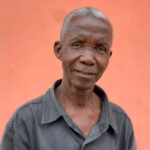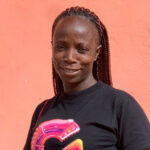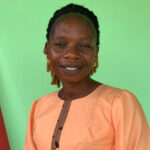Written by: Satta S. Kollie, Emmanuel G. Zaizay, Jallah Kessellie, Kebeh Lavala, Christopher Morris, Hagar Kruah, Robert G Jaffa, Harrison Wenjor.

REDRESS Co-Researchers with their ripple effect maps
We are a group of eight co-researchers who are a mixture of health workers who care for persons affected by skin NTDs and a person affected by a skin NTD. We have been working as co-researchers as part of the REDRESS project for the last four years. After carrying out ripple effect mapping[1] to understand the impact of our co-researcher role, we reflected together on the roles we have played; the types of mentorship we have received; the impact of our co-researcher role on our routine work within the community and health system; the impact on us individually.
[1] Ripple effect mapping is a method of capturing program/activity/research specifics by narrating a story. This is a participatory method that engages participants to see connections among the effects they describe. We produced maps to describe the story of how the mentoring process and programme activities have impacted coresearchers, and the wider community.
Roles played as co-researchers and in routine work
As coresearchers we have played dual roles. Some of us are community health service supervisors (CHSS), and as part of this role we carry out community awareness in our communities to tell any person affected with a disease they will be able to come to the facility for care. We supervise community health assistants (CHAs) and community health promoters (CHPs) in using their NTD job aids, and helping them to identify patients that they should refer to the health facility. Alongside this, in our co-researcher role we collected data, by surveying patients. Sometimes when surveying a patient, we also did some counselling, because some patients are discouraged, so as a coresearcher we need to counsel them. As a coresearcher we also did some mentorship with health workers at other facilities. When we are visiting a facility to collect data, if we see there are gaps e.g. in record keeping, then we give them mentorship on how to fill the ledger. Some of us also played a role as part of the community advisory board, where all the members and leadership discuss how people can be healed. Other responsibilities included taking part in radio talk shows to help people to understand the importance of NTD. Through all these roles we have learnt the importance of confidentiality and keeping patients’ secrets, so that people will confide and trust in you.
Types of mentorship and training received
As part of the REDRESS intervention we took part in the intervention training where we learnt about case detection of NTDs. We also received training in our role as co-researchers including training on how to carry out different types of research methods including: how to conduct focus group discussion, key informant interviews and in-depth interviews, bodymapping, reflective diary and photovoice from the REDRESS research fellows and LSTM staff. We also learnt new skills including notetaking, how to use a recorder, using the tablet and REDCAP upload, filling trackers and how to do health facility ledger review and report writing. Another form of mentorship we received was learning how to take part in podcast, and we were able to put this into practice when recording two podcasts Being a co-researcher with lived experience of an NTD: ‘I was very much proud’ and Improving mental health services for people affected by NTDs: Perspectives of community health workers in Liberia. Learning how to take notes has also helped us in our routine work, where we can use these new skills. We learnt these skills through face to face training and then follow up discussions in person and by phone call with each other and with research fellows.
As coresearchers we worked together as a team using Whatsapp chatrooms, where we could reach out to each other and to research fellows to ask questions about any challenges we were having.
Impact of our role on routine work within community and health system
In the community our impact was to help the community to feel connected to the health system through health promotion, and for the community to be integrated in the health system by creating awareness to encourage the community to take responsibility for their own health. As a result of the training for traditional and faith healers they are now helping the community to reduce stigma and discrimination towards persons affected. There is more referral of patients to seek care and treatment at the facility and this has increased the number of cases reported in DHIS2, and we can now see how creating a link between traditional and faith healers and the health system supports the health system. Importantly, we have helped community dwellers to believe that NTD cases can be treated, and we have been able to reduce stigma in the community through awareness. When we visit with persons affected as part of photovoice this helps people to gain hope.
When it comes to impact as a co-researcher on the health system, we helped the health system to support quality data. Through the co-researcher role we now have a greater understanding of the need for quality record keeping to have a clear data pathway. This has impacted our own record keeping, as well as guiding us to encourage other health workers to improve their record keeping as well (see above). Before some of the health workers were stigmatising persons affected, but now we meet with them and we are seeing their behaviour change because now they see people affected as individuals and so facility staff now treat people affected equally, and we encourage them to keep confidentiality.
Impact of coresearcher role on us individually
Through our role as co-researchers our own attitudes towards persons affected have changed. We can now collect quality data at all levels, including carrying out patient survey. The impact we have had in the community, reducing stigma, raising awareness and helping people affected by skin NTDs to have hope makes us to feel proud in our communities, and in our counties. With the knowledge and skills gained, now we can talk to health workers about NTD cases. Being a co-researcher has increased our knowledge of research work and our self-confidence. For those of us who are CHSS we have grown in various supervision techniques which are part of our CHSS role.
“I feel empowered and that I am well nurtured as I have more knowledge on research and leadership, I have more knowledge about interviewing patients and keeping confidentiality. It makes me to feel fine in myself to help someone get good feeling, when they are happy I am happy. It makes me feel good in the sense that within the community I am the one that will be praised … It makes me feel confident and relaxed in my job, and to feel more proud and reliable that I can do this work.”
REDRESS Co-Researcher
Reflections on using ripple effect mapping

Harrison Wenjor
“My reflections are that being a co-researcher has built up my skills and thinking, it built up my work as a fieldman and it make me to better doing what I’m not used to. From here it built me up”.

Kebeh Lavalla
“Yesterday was my first time to do ripple effect mapping, it made me to think critically, which made me to think about the work and remember my role as coresearcher and also as CHSS. The impact of that on my CHSS work is for coaching and mentoring for CHAs.”

Hagar Kruah
“When it comes to ripple effect mapping, it reminded me of all the work we have been doing, of me being a coresearcher from the beginning, the baseline and intervention phase. It also helped me because as a CHSS when I’m mentoring the CHAs you should be able to summarise everything, so this work is also about summarising everything.”

Satta Sonnie Kollie
“I actually love because it has helped to build my knowledge especially in terms of research.”

Emmanuel Zaizay
“From this ripple effect mapping what I understand is that it’s a reminder of what you did to show your good work and some challenges that you had during the time, what I really enjoy about this is seeing my activities and seeing the similar things [with the other coresearchers] so I think it’s a good idea.”

Jallah Kesselie
“Its like experience sharing in what we have been learning from the past, carrying my mind back to the mentorship aspect where I learnt a lot from my fellows, from trainings and from other coresearchers as well, during every meeting times we always have that time of sharing experiences and when it comes to the impact it has impacted a lot to my career as a CHSS and as a coresearcher, because it built my capacity up doing quality research work.”

Robert Jaffa
“I am seeing myself in the middle of the entire process, you divide from the centre, I have a lot of responsibilities to perform meaning that if I don’t do the patient survey the voice of the patient will not be heard and if I don’t visit the health facility to check the ledger, the information there will not be disseminated.”

Christopher Morris
“REDRESS taught me how to do quality data collection and through REDRESS I have learned how to do quantitative and qualitative research. For example, I learnt how to do patient survey, health worker survey and I have learnt how to do photovoice with affected people with NTDs, reflective diaries with health workers. Through REDRESS I am currently attending the University of Liberia to further my studies.”
This was funded as part of TDR Global Equity and Inclusivity in Research Mentorship Open Call
